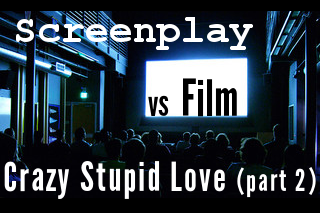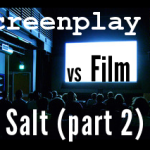Of course I was curious about the spec screenplay, Crazy Stupid Love. It caught the attention of Steve Carell, and it sold for two million dollars. You’re probably curious about it too. Well, I’ve got what the script doctor ordered:
Yesterday, I wrote about some of the screenwriting tips I learned by comparing the screenplay to the movie version released in theaters. But those were only half of the screenplay writing techniques I learned.
Here are the rest!
Screenwriting Tip #7: Skip the “falling in love” montage
As a romantic comedy junkie, I’ve seen my fair share of falling in love montages. They’re a rom-com staple, but they’re not the only way to show your main characters falling in love. Showing a scene of non-sexual intimacy and/or vulnerability between your characters can be as, if not more, effective as a montage.
In the Crazy Stupid Love spec screenplay, Fogelman opted for the montage:
JACOB’S “I’M THE ONE WHO WANTS TO BE WITH YOU” MONTAGE:
– Jacob and Hannah are instantly inseparable, doing everything “couple-y” and “un-Jacob-Palmer-y” you can imagine.
– They hit a local farmer’s market, buy produce. Produce!
– They COO at a BABY. An UGLY BABY!
– They KISS, for no reason. For no reason!
– They read morning newspapers together at Jacob’s place. She fixes his bed-head.
– They go to a MET’S GAME. Hannah gets mustard on her face. Jacob kisses it off.
– They jump to their feet when someone hits a HOME RUN.
– PULL BACK from the PLAYER rounding the bases. It’s on TV.
– Cal is WATCHING THE GAME at the bar. He’s alone. He looks to the empty seat next to him. He’s clearly been abandoned.
[Editor’s note: This segues into a nice montage starring Cal and his lonely heart.]
The movie dumped the montage and went one better. Hannah and Jacob are in bed, but they’re not doing it. Instead, they’re discussing Jacob’s collection of incredibly useless and expensive gadgets. It’s an intimate scene with barely any physical intimacy. Jacob even asks Hannah to do him a favor and ask him something personal about himself.
In the world of Jacob, this is huge. Jacob NEVER talks about himself. NEVER. He even instructs Cal not to talk about his personal life either. But with Hannah, Jacob is willing to share personal information about his parents. He’s made himself vulnerable, and that’s a major reversal for him.
After talking all night, Jacob falls asleep, and Hannah tucks him in. Again, something intimate and vulnerable, and something completely different for Jacob. Cause he always sleeps with the girl. ALWAYS.
The reversals in this scene convey, far more effectively, Jacob’s change of heart than any montage could hope to accomplish. (I should note that the spec screenplay had part of this scene, but it was much longer in the movie.)
If you’re writing a romantic comedy, don’t automatically scrap the montage. They do have their place and they can accomplish their purpose. But sometimes, like with Crazy Stupid Love, a fully fledged scene with moments of intimacy and vulnerability is the better way to go…especially if you have to convince a skeptical audience that Jacob has really abandoned his hound dog ways and that his feelings are authentic.
There’s nothing to prevent you from using both techniques. Take Notting Hill. There’s a montage of William and Anna doing all these lovey-dovey things in London, set to the tune of Ronan Keating’s When You Say Nothing At All. But later, the morning after the first time they’ve slept together, Anna, this world-famous actress becomes just a vulnerable girl:
ANNA
Rita Hayworth used to say–‘they go to bed with Gilda–they wake up with me.’ Do you feel that?
WILLIAM
Who was Gilda?
ANNA
Her most famous part–men went to bed with the dream–and they didn’t like it when they woke up with the reality–do you feel that way with me?
WILLIAM
(pause)
You’re lovelier this morning than you have ever been.
ANNA
(very touched)
Oh.
It’s moments of intimacy and vulnerability like that–not a montage–which make people want to see a movie over and over again. If you do want to write a scene like the ones I’ve described, make sure your character is being vulnerable in a way that is specific and unique to himself. That’s the only way to achieve maximum emotional impact.
Screenwriting Tip #8: Exploit even the tiniest opportunities to add conflict
You can never have too much conflict in your screenplay–as long as it’s organic to the scene. In the screenplay and movie, there’s a scene towards the end, right before the climax, when Jessica’s dad, Bernie, realizes that Jessica was planning on sending nude pictures of herself to Cal.
Bernie rushes out of his house, with the intent to murder Cal. Of course Jessica doesn’t want to get her crush in trouble (or murdered), especially since Cal doesn’t have a clue about her feelings. So, she chases after her dad.
This scene is chock full of actual conflict, enhanced by anticipation of the conflict about to unfold between Bernie and Cal. How could you possibly add MORE conflict to his scene?
By throwing Jessica’s mother into the mix…like the way they did in the movie. Jessica’s mom chases after Jessica, trying to prevent her daughter from taking her car keys so that Bernie can attack Cal without interruption. She’s so hellbent on her mission, she even tries to tackle Jessica.
That’s how you add more conflict: take an element–could be a person, could be an object–which would occur within the scene organically, and turn that element into an obstacle which must be overcome in order for the main character in the particular scene to achieve his/her goal.
After the kickbutt climax, which is basically a smackdown between Cal and Jessica’s dad (and a whole host of other characters), the screenplay had this moment between Cal and his son Robbie:
Tracy follows after them. She stops at the door.
TRACY
The miniature golf thing would have been cute.
CAL
Yeah, well, told you I’d screw it up.
(then, turning to Jacobowitz)
She’s all yours, David.
Ouch.
TRACY
(wounded)
Nice.
(then, to kids)
C’mon, Guys.
Molly runs after her mother. Robbie walks over towards Cal, pats his back.
ROBBIE
Go big or go home, right?
Cal smiles, sadly.
CAL
It’s time to go home, Buddy.
Robbie NODS, EXITS after his mother and sister.
The end of this scene doesn’t quite gel. Robbie is madly in love with Jessica and has just learned that Jessica was in love his dad. For Robbie, this is a major betrayal.
But he doesn’t act betrayed. Instead, he acts like the grown up in the situation, offering his dad comfort and support–which means there’s no conflict.
In the movie, the lines were reversed. Cal says to Robbie, “go big or go home, right?” and Robbie replies with disgust, “go home, dad.” This little switcheroo maintained the conflict–and now Cal has to repair another rift, in addition to the ones he has with Emily, Hannah and Jacob.
I guarantee you that every scene in your script right now could contain even more conflict that it already does. Go through your most recent screenplay draft. Do you see missed opportunities to increase the conflict?
Asking yourself these questions might help: What elements are already present in your scene which could turn into obstacles? Should you switch lines between your characters? Do you have a character react with acceptance after a nasty fight…instead of with anger, frustration or disgust?
Which leads me to my next screenwriting tip…
Screenwriting Tip #9: Your hero has to earn the happy ending
Although I’m totally in love with the climax of Crazy Stupid Love, the ending in the screenplay was too rushed. In screenwriting tip #8, I showed you that Robbie was too accepting of his dad’s mess. The scene just didn’t feel right.
It took me awhile to put my finger on what was wrong, but then I realized that Cal and his son mended their rift too easily–as was the rift with Jacob–
Cal looks up.
JACOB (CONT’D)
I love your daughter. I’ve never been in love before. Honestly, I’ve never even been in “like” before.
(then)
I never got it. I saw people in love – I saw weakness. I heard them say the things they said, and do the things they do, it all just seemed so…so pathetic.
(then)
She’s my perfect combination of everything, Cal.
Cal sits on this for a beat, looks Jacob in the eye – it’s real. Jacob means it. Cal sees that, instantly.
And then…Cal LAUGHS. Soon, he’s hysterical (we saw his daughter’s laugh evolve like this once).
Jacob smiles, unsure what’s happening.
CAL
You sound…
He can’t even complete it, he’s laughing too hard. Finally, he gets out:
CAL (CONT’D)
You sound like such a LOSER!
He’s hysterical.
CAL (CONT’D)
You sound like ME!
JACOB
I do not sound like you.
CAL
You do.
(imitating)
“She’s my perfect combination of everything, Cal!”
Dying. He STANDS, calms down, and throws his hands in the air…giving up.
CAL (CONT’D)
I already ordered a gun. I’m not kidding. I ordered a Colt 45 on a shady internet site, I can show you the receipt. If you hurt her, I am prepared to shoot you in the face.
JACOB
Cal, I’m not gonna hurt–
CAL
Shut up, Jacob.
Jacob does. Cal realizes: the power has finally switched.
CAL (CONT’D)
Okay, fine. What can I do? Go ahead: marry my daughter.
–and even the one with Emily:
EXT. GRADUATION CEREMONY – LATER
Tracy, Molly, and Hannah sit in the audience. Jessica sits with them. All look nice.
Cal (shaven and well-dressed) and Jacob make their way down the row towards the TWO EMPTY SEATS being held for them.
Cal smiles uncomfortably at Jessica: they are both VERY careful to avoid body contact.
Cal hugs MOLLY (she’s excited to see him).
He leans down toward HANNAH, she looks hesitant. He kisses her on the forehead. His look says it all: he’s sorry.
She smiles. So does…TRACY. Cal sits down next to her. They don’t say anything, nor look at each other.
Note: The following conversation takes place, eyes forward, looking at the STAGE (where festivities are beginning) the entire time.
TRACY
Where have you been, Cal?
CAL
I took a vacation.
TRACY
Where’d you go?
CAL
A bar.
A beat. We WATCH the ceremony for a moment. The PRINCIPAL labors through her introduction. After a long beat of that…
CAL (CONT’D)
Can I ask you something? Do you think we can ever come back from all of this?
TRACY
I don’t know, Cal. I really don’t know.
Another beat. More CEREMONY.
CAL
I’d like to try.
TRACY
What if we keep screwing up?
CAL
I’ll try again.
(then)
The thing is: there’s only one thing in the whole world I love more than you, T.
TRACY
Robbie’s English teacher?
CAL
Yes, but she doesn’t like me anymore.
A big LAUGH escapes Tracy’s mouth, someone turns around.
TRACY
Sorry.
Cal turns his body towards her. Smiles, gently.
CAL
Us. The only thing I love more than you, is us.
Tracy smiles, turns back forward.
TRACY
We’d have to go to serious therapy.
CAL
Alright, we’ll see if we need that–
VOICE (O.S.)
And to introduce the first student speaker: our very own English teacher Kate Thompson!
Cal’s former conquest steps onto stage. Cal turns to Tracy.
CAL
Yeah, some therapy probably couldn’t hurt.
While the scene with Cal and Emily is cute, it’s a little too neat, too swift, too tidy. After everything Cal has done, there’s a seat waiting for him at graduation?! Really?! Everything was wrapped up in a bow, without Cal really making a dramatic move to restore his world to rights.
Satisfying endings aren’t made by handing your hero forgiveness on a silver platter. Not after they royally bungle everything up. Audiences want to see your character make amends–usually in the form of some kind of public humiliation.
While I’m not overly fond of Cal’s graduation speech at the end of the movie, I think it works infinitely better than the ending in the script.
Screenwriting Tip #10: Write with boldness
Okay, so these last two screenplay writing tips have nothing to do with comparing the script to the movie, but come from a cold read of the script itself…
You’re probably all familiar with the screenwriting rule to only write what can be seen. (Although there seems to be a little leeway when you’re introducing a character for the first time.)
The thing is though if you sprinkle a few “unfilmables” in your screenplay or speak to the reader directly, your script can radiate confidence that’s really compelling. Take the beginning of Crazy Stupid Love:
PULL UP, revealing CAL WEAVER (44) and his wife, TRACY (42). A handsome couple. He’d be JFK to her Jackie O…if he gave a s***. Unfortunately, he doesn’t (ie: white sneakers in fancy French restaurant).
The minute I read the JFK part (and it’s on the first page), I felt like I was in capable screenwriting hands. That’s what writing with boldness does.
Here’s another example, this one from page 4:
INT. CAL AND TRACY’S HOUSE – MEANWHILE
Jessica (the baby-sitter) stops at a bedroom door. She hears MUSIC coming from inside. She puts her ear to door.
It’s Lady Gaga. It’s awful.
She smiles, knocks and opens the door at the same time.
The “it’s awful” commentary is a judgement. It’s not filmable at all, but it’s funny, and bold–and again, very compelling.
If you don’t go overboard, a few asides, judgements, and unfilmables can help your voice stand out from the crowd. If you want a few more examples, check out screenwriting tip #5 from Taken.
Just be careful. Not everyone will like your attempts at boldness, and they certainly won’t appreciate them at all if you’re trying to use this tactic to cover up lazy screenwriting.
Screenwriting Tip #11: Master subplots
If subplots confuse the hell out of you, then study Crazy Stupid Love. The script, the movie; both will suffice. If you do study either one (or both) carefully, you’ll start to understand how these subplot thingys work. You’ll see that they don’t hang flaccidly onto a script like the arm fat of a three hundred pound woman. Subplots are woven into the script, they’re fully integrated into the story.
Take Jessica for example. She’s a babysitter for Cal and Emily. She’s in love with Cal. Robbie, Cal’s son, is in love with her. To top it all off, Jessica’a dad is Cal’s best friend. In other words, Jessica’s presence isn’t random. When you’re trying to create a subplot of your own, look at who would naturally be a part of your main character’s world–then work backwards from there to create a mini storyline or subplot.
Good subplots aren’t just integrated into the story, they usually directly impact the main character’s choice of action. In Crazy Stupid Love, Cal tries to get into the dating game with the help of Jacob…and ends up sleeping with Robbie’s teacher. This action jeopardizes his overall goal of winning back his wife.
Cal seems totally out of the game, until Robbie–who needs inspiration in the love department since nothing he’s done is working on Jessica–encourages his dad not to give up. This motivates Cal to try yet again, keeping the plot moving, and paving the way for the climax which brings all the subplots together in one giant smackdown.
Finally, subplots are a great way to explore theme. What’s the theme of this movie? That love makes us do crazy, stupid things…that we have to do crazy, stupid things to keep love in our lives. And every single character in Crazy Stupid Love, every single one, is a reflection of that theme. From Cal and his wrecked marriage to Jessica and her inappropriate crush even down to Molly, whose love for High School Musical turned her into a zombie. (Note: this minor subplot was mostly excised in the movie).
If you’re having trouble coming up with a subplot, think about the theme you’re trying to convey. How can characters who are already a part of your protagonist’s life express that theme? For example, let’s say you’re writing a movie whose theme centers around greed. Your main character is at a crossroads–he can either turn into a rich, unethical bastard, or settle for less money and keep his scruples.
If you wanted to throw some subplots into the mix, examine the other people in your protagonist’s life–his friends, colleagues, and family. His ex-wife could be a greedy witch who wrecked their family in order to ascend the social ladder. But your hero’s still in love with her–and if does the unethical thing, he’ll win her back. That’s the making of a subplot. It’s hardly an original idea, but you should get the picture: subplots are a way for you to expound on your theme without getting preachy.
Final thoughts
I think Crazy Stupid Love sold for so much money because of the way it skillfully handled the climax, subplots, and theme. Weaving together the most basic elements of screenwriting, and turning them into something special–without a high-concept hook–is something which requires dedication, butt-in-the-chair-writing…and time.
It doesn’t happen overnight, or even within a few months. It takes years. You’re on the right path now, and if you just continue, you’ll get there too. Good luck!
Watching a blank screen (with modifications) by Kenneth Lu





















Comments on this entry are closed.
Hi,
I really appreciate your screenwriting tips.
I have a suggestion that might improve your web site: Consider grouping tips by genre, check out John Truby’s web site as an example. This way you will make it easy for writers who want learn the tricks of the trade by genre to find stuff on your web site.
Hi Sean,
Thanks for the suggestion. It’s a good one!